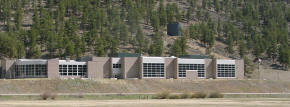Mr. Ghist's Science Page
Platte Canyon High
School
Bailey, Colorado

SCIENCE
STANDARDS
3
|
Mr. Ghist's Science Page |
Platte Canyon High
School |
|
 |
SCIENCE
STANDARDS |
|
| ================================================== | ||
Students know and understand the characteristics and structure of living things, the processes of life, and how living things interact with each other and their environment
|
BENCHMARKS 3.1 Students
know and understand the characteristics of living things, the diversity of
life, and how living things interact with each other and with their
environment.
3.2 Students
know and understand interrelationships of matter and energy in living
systems
3.3 Students
know and understand how the human body functions, the factors that
influence its structures and functions, and how these structures and
functions compare with those of other organisms.
3.4 Students
know and understand how organisms change over time in terms of evolution
and genetics
|
| GRADE LEVEL
EXPECTATIONS:
Guiding
questions: ∑
What
are the characteristics of living things and how do they interact with
their environment? ∑
What
are the interrelationship of matter and energy in living systems? ∑
How
does the human body function and how does this compare with other living
things? ∑
In
what ways are living things adapted to survive in their environment? ∑
How
do species change over time in terms of biological evolution and genetics? Expectations: understand
that life processes of plants and animals depend on a variety of chemical
reactions that are carried out in specialized areas of the organism's
cells use
and produce a variety of classification systems for organisms compare
and contrast the purpose and process of cell division (mitosis) with the
production of sex cells (meiosis) understand
that a multi-organism develops from single zygote and its phenotype
depends on its genotype, which is established at fertilization understand
that genes are a set of instructions, encoded in the DNA sequence of each
organism that specify the sequence of amino acids in proteins
characteristic of that organism understand
the role of DNA in resolving questions of relationship and evolutionary
change understand
that the genetic composition of cells can be altered by incorporation of
exogenous DNA into the cells predict
and describe the interactions of populations and ecosystems understand
the concepts of mutation, natural selection, and reproductive isolation
impacts on the planetís bio-diversity calculate
the probability that an individual will inherit a particular single gene
trait compare
and contrast the processes of photosynthesis and respiration explain
how large molecules are broken down into small molecules serving as an
energy source or as basic building blocks in organisms explain
how energy is used in the maintenance, repair, growth, and development of
tissue describe the cycling of matter and the movement and change of energy through the ecosystem |
| ================================================= |